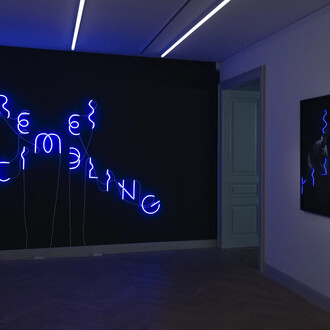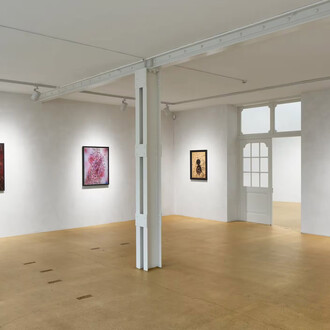Basel-resident Anna Winteler (b. 1954, Lausanne) has, since the early 1980s, been among the most significant Swiss video and performance artists. She has had an enduring influence on the scene, with many younger artists responding directly or indirectly to her — no exhibition on Swiss video or performance art omits her work. Her work has equally been valued abroad, with great interest in the 1980s and ‘90s in particular. Yet a comprehensive exhibition of her video works from the 1970s to ‘90s is still overdue. This video-retrospective will be accompanied by a publication supported by the Binding Sélection d’Artistes.
Anna Winteler is exceptional, not just in the Swiss video and performance scene. Born in Lausanne in 1954 and grown up in Perreux/Canton Neuenburg, as a young woman she completed training in music and in dance in particular. Subsequently she went to London, Cannes, Stuttgart and Paris in the early 1970s before she moved to Basel in 1978. Winteler’s very first video work Le Petit Déjeuner sur la Route d’après Manet from 1979 drew significant attention. Placing herself in front of the lens, the artist walks, in the early hours of the morning, in a line from Basel’s Mittleren Rheinbrücke to the Wettsteinbrücke bridges, upstream and against the current, dispensing with her strikingly feminine clothing as she does so.
The body and its movements in a space are indeed the key topics that define Anna Winteler’s practice. The body becomes a system of coordinates for her, as well as a point of orientation within a spatial situation, inside or outside; it provides above and below, right and left. In Winteler’s work the female body is not an erotic and fragile thing that must be shown and recorded; instead with each step and action the body must maintain its balance and must, at the same time, be drawn towards its physical limits. A body that defines itself, that moves confidently, which falls, stands up again, falls again and fails — but which remains intact. The body measures space through movement and makes the space its own in the process. Mountain ranges slide into corporal landscapes. Discours des Montagnes à la Mere / Speech from the Mountains to the Sea ( — to the Mother): the camera observes the whole, or is directed to parts like the torso, the head or the hands, which carry out everyday movements like pouring and drinking tea, lying down gently and touching each other, only to strike the wall in the next instant.
Any given work by Anna Winteler is based on a precise concept, though they are not rehearsed, repeated or indeed corrected. The shooting location, the people acting — generally alone — in front of the camera, the setting and the camera movement which either she or a camera operator, often Reinhard Manz, deals with — are defined once. There are scarcely any edits. The experience of real time is essential in Anna Winteler’s video works, not least so that this physical element is accessible to the viewer. Often a subject is parsed in several works before she moves on to a new one. It seems logical that she does not repeat herself. There is no look backwards.
Since she began her practice, Anna Winteler has never been interested in developing a recognisable, repeating signature style. This is reflected in her career, which does not accord with the customary, formal artist’s biography but instead follows its own internal logic. There are videos, dance, body works and performances. The fact that Winteler turned away from active art production in the 1990s but nonetheless continued her intense work with the body seems more of a logical consequence than a rupture. Over the period from 1979 to 1991 about 30 major video works were created, almost like an eruption, accompanied by numerous live performances such as the Holzperformance (Wood Performance) which she realised in Basel, Zurich and also in various locations in Germany. The broad appreciation for Anna Winteler’s work is in part due to her own active personality. Her radical yet deliberate works are attentively followed by the public, and by other artists in particular, internationally and across different disciplines.
The reason why Anna Winteler’s works are both specifically meaningful and of contemporary relevance lies in the engagement with video and with the body in particular which she maintains to this day. This is particularly significant in light of the ongoing discourse around the body, self-determination and being able to experience the world through one’s own body.
A survey of Anna Winteler’s extensive video work from the late 1970s to the early 1990s has, till now, been wanting. Now seems like a particularly opportune moment to honour this work in the form of an exhibition and an accompanying publication. Nearly all the relevant video works could be transferred to digital media and prepared for display. Anna Winteler herself was involved in this survey, opening her entire video and photographic archive and facilitating this exhibition, which is both retrospective and a look to the future, through her deep engagement. A fortuitous additional element came about with the involvement of artist Käthe Walser, who has known Anna Winteler as a colleague since the 1980s and who has significantly assisted in the realisation of several exhibitions. Personally, I have known Anna Winteler’s work for just a few years, and only as I do now since this exhibition project began. Our collaboration has created the particular appeal of the whole project. Instead of reconstructing the past, here in the foreground stands the possibility of contemporary, tangible experience, without doing away with actually presenting the works. Our aim was to reveal Anna Winteler’s work to a generation who have long not been able to access her work from a contemporary perspective, in light of current-day concerns. At the same time, we wanted to uncover new perspectives for those who have known the work well since the 1980s. This we wanted to achieve while doing justice to a person who is indisputably one of the most important Swiss video and performance artists, and to her work.












